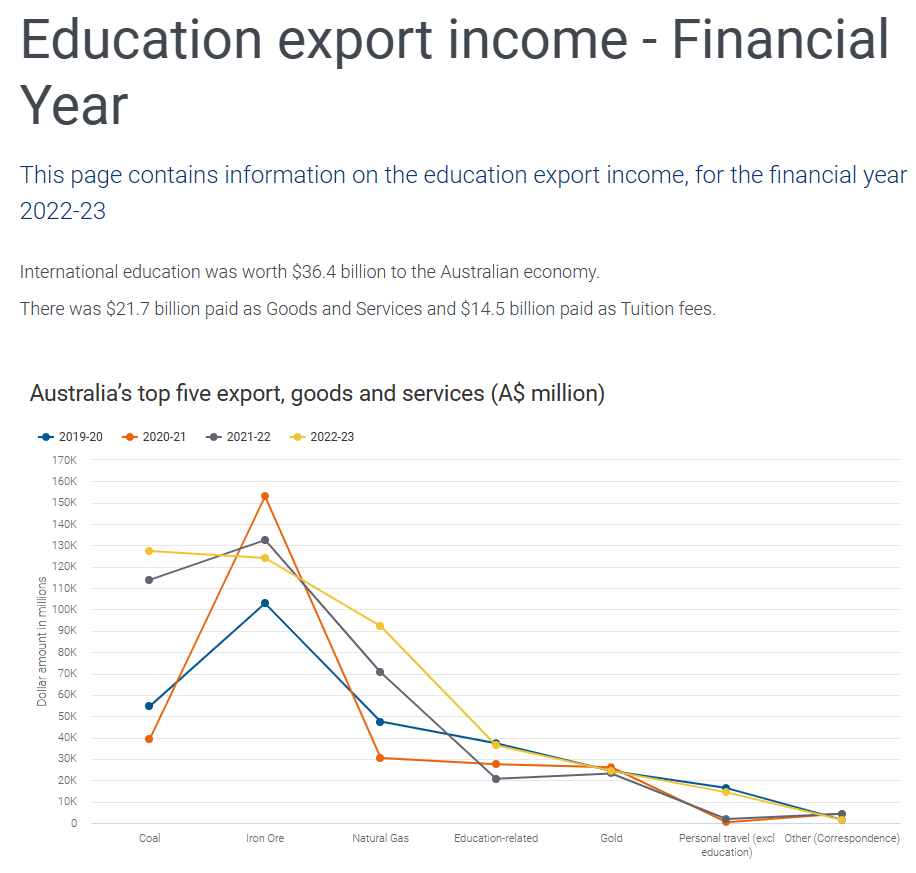Over many years, Macro Business has argued that it is a myth that international education is a vital export industry for Australia.
As shown in the next chart from the Department of Education, international education contributed $36.4 billion in exports in 2022-23, making it Australia’s fourth largest export after coal, iron ore and liquified natural gas:

The truth is that international education is a people-importing industry, not a true export industry.
The ABS export estimates are false because they include all expenses incurred by foreign students in Australia as exports, even if the money was earned while working in Australia.
Most student visa holders come from low-income countries and start working in Australia right away to fund their living and tuition expenses.
Australia’s best journalist, Frank Chung, debunked the international education export “scam” once and for all in investigative report published on Monday at News.com.au.
“The tuition is not export revenue”, University of Sydney Associate Professor Salvatore Babones told Chung. “International student tuition is overwhelmingly not paid from abroad”.
“At the postgraduate level I suspect most international student tuition is being paid out of earnings in Australia, either directly or indirectly by repaying unreported loans”.
“That is, someone borrowed money five years ago, put it in a bank account to show they can pay the tuition, pay the tuition out of the bank account, but their work earnings are paying that loan off”, Babones said.
The practice was “absolutely routine” in India and Nepal for students to “game the financial requirements” by getting loans from family or even loan sharks years in advance to secure a visa, according to Prof Babones.
“Those funds are never coming to Australia,” he said.
Salvatore Babones noted similar in his recent book, “Australia’s universities, can they reform”:
“In reality, everyone (except perhaps the government and the universities) knew that many international students pay for their courses out of the proceeds of their work in-country, often working excessive hours under exploitative conditions, in violation of their visa terms”.
“This situation is especially common among South Asian students, and is reflected in the steep fall-off in South Asian student numbers when teaching moved online”.
“With prospective students unable to rely on employment income in Australia to support their studies, new commencements of Indian students at Australian higher education providers fell 65% between 2019 and 2021; for Nepali students, the decline was 37%; for Pakistanis, 45%; for Sri Lankans, 54%”.
“These countries are simply too poor to send large cohorts of international students to Australian universities based on family resources alone”.
“For many South Asian students, a student visa is a very expensive but thinly disguised work visa”.
The Australian’s Judith Sloan also took aim at the fake international education export claim on Tuesday:
It is essentially a myth that international education is an export industry, notwithstanding its classification by the Australian Bureau of Statistics as such. Indeed, O’Neil has proudly declared “international education is our fourth largest export” and needs to be protected.
Exports are defined as goods and services produced in one country and sold to buyers in another.
With international education, the expectation was that students would convert their foreign currency to pay the fees and living expenses while studying here.
The reality is very different. While some initial fees may be paid from abroad, most international students work while studying to cover their living expenses and further fees.
This is not an export activity. We don’t count the entry of temporary workers as an export.
The export myth was categorically debunked during the pandemic when large numbers of international students sought assistance from charities and food banks, as well as requested financial assistance from universities and taxpayers.
Many so-called international students have also registered with low-cost private colleges with the primary intention of permanently living and working in Australia.
The inaccurate measurement of education exports gives Australians the impression that the industry is vital earner for the nation.
The truth is that the overwhelming majority of these “export” earnings are generated from within Australia via low-skilled and low-paying jobs like driving Uber.

